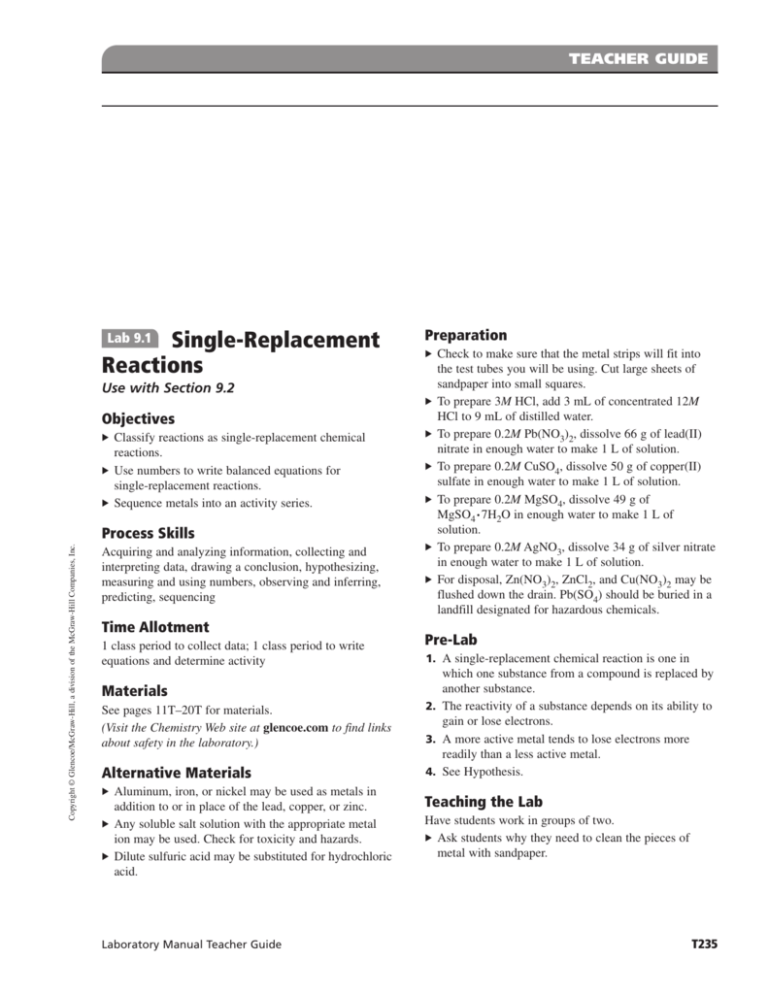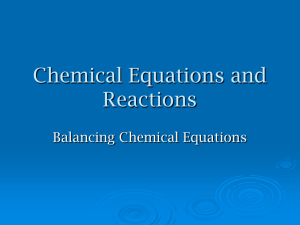Single-Replacement Reactions: Teacher Guide
advertisement

Data Table 3 TEACHER GUIDE Preparation ▲ Single-Replacement Reactions Lab 9.1 Use with Section 9.2 ▲ Objectives ▲ ▲ ▲ ▲ ▲ ▲ Classify reactions as single-replacement chemical reactions. Use numbers to write balanced equations for single-replacement reactions. Sequence metals into an activity series. 1 class period to collect data; 1 class period to write equations and determine activity Materials See pages 11T–20T for materials. (Visit the Chemistry Web site at glencoe.com to find links about safety in the laboratory.) Alternative Materials ▲ Laboratory Manual Teacher Guide Pre-Lab 1. A single-replacement chemical reaction is one in which one substance from a compound is replaced by another substance. 2. The reactivity of a substance depends on its ability to gain or lose electrons. 3. A more active metal tends to lose electrons more readily than a less active metal. 4. See Hypothesis. Teaching the Lab Have students work in groups of two. Ask students why they need to clean the pieces of metal with sandpaper. ▲ ▲ Aluminum, iron, or nickel may be used as metals in addition to or in place of the lead, copper, or zinc. Any soluble salt solution with the appropriate metal ion may be used. Check for toxicity and hazards. Dilute sulfuric acid may be substituted for hydrochloric acid. ▲ Time Allotment ▲ Acquiring and analyzing information, collecting and interpreting data, drawing a conclusion, hypothesizing, measuring and using numbers, observing and inferring, predicting, sequencing ▲ Copyright © Glencoe/McGraw-Hill, a division of the McGraw-Hill Companies, Inc. Process Skills Check to make sure that the metal strips will fit into the test tubes you will be using. Cut large sheets of sandpaper into small squares. To prepare 3M HCl, add 3 mL of concentrated 12M HCl to 9 mL of distilled water. To prepare 0.2M Pb(NO3)2, dissolve 66 g of lead(II) nitrate in enough water to make 1 L of solution. To prepare 0.2M CuSO4, dissolve 50 g of copper(II) sulfate in enough water to make 1 L of solution. To prepare 0.2M MgSO4, dissolve 49 g of MgSO47H2O in enough water to make 1 L of solution. To prepare 0.2M AgNO3, dissolve 34 g of silver nitrate in enough water to make 1 L of solution. For disposal, Zn(NO3)2, ZnCl2, and Cu(NO3)2 may be flushed down the drain. Pb(SO4) should be buried in a landfill designated for hazardous chemicals. T235 TEACHER GUIDE Data and Observations (Lab 9.1) Sample Data Data Table 1 Test-tube number Indication of a chemical reaction 1 Copper forms on the lead strip. The blue color of the solution slowly becomes less intense. 2 Shiny silver deposits form on copper strip. 3 no reaction 4 Shiny zinc deposits form on the lead strip. 5 no reaction 6 Bubbles of gas form on the zinc strip. The bubbles rise to the top of the test tube. Hypothesis copper, which is more active than the silver. Zinc replaced the hydrogen from hydrochloric acid. Therefore, the zinc is more active than hydrogen. Zinc did not replace magnesium from solution. Therefore, the magnesium is more active. 9. It would be necessary to test lead with hydrochloric acid to establish if lead was more active than hydrogen. 10. The activity series should match. Any differences could be caused by mislabeling, failure to recognize the evidence of a reaction, or solutions that are too dilute. The reactivity of an element can be determined by observing its reaction tendencies with other elements. A more active metal will replace a less active metal ion from solution. Data and Observations See Data Table 1. Analyze and Conclude 1–2. See Data Tables 2 and 3. 3. Zn is the most active. 4. Cu is the least active. 1. Steel is iron with a regulated amount of carbon. The more active than Cu. Zn replaced Pb from solution. Zn is therefore the most active of the three metals, and Cu is the least active. 6. Ag, Cu, Pb, Zn, Mg 7. Hydrogen is more active than silver or copper but less active than zinc or magnesium. 8. Copper did not replace hydrogen from hydrochloric acid. Copper did not react with silver nitrate. Therefore, the hydrogen is more active than the iron is more active than hydrogen. and a replacement reaction would take place, disintegrating the container. 2. Sodium is very active because it has a tendency to lose electrons easily. Therefore, sodium reacts readily in nature to easily form compounds. 3. Magnesium is more active than copper and would react easily with the acid. Analyze and Conclude (Lab 9.1) 1. Data Table 2 Test-tube number 2. Data Table 3 Test-tube number Symbol of more active element Symbol of less active element 1 Pb Cu 2 Pb CuSO4 0 PbSO4 Cu Cu AgNO3 0 Cu(NO3)2 2Ag 2 Cu Ag 3 Cu HCl 0 no reaction 3 H Cu 4 4 Zn Pb 5 Zn Pb(NO3)2 0 Zn(NO3)2 Pb Zn MgSO4 0 no reaction 5 Mg Zn 6 Zn HCl 0 ZnCl2 H2 6 Zn H 1 T236 Sample Data Chemical equation Laboratory Manual Teacher Guide Copyright © Glencoe/McGraw-Hill, a division of the McGraw-Hill Companies, Inc. Real-World Chemistry 5. Pb replaced Cu from solution, establishing that Pb is











